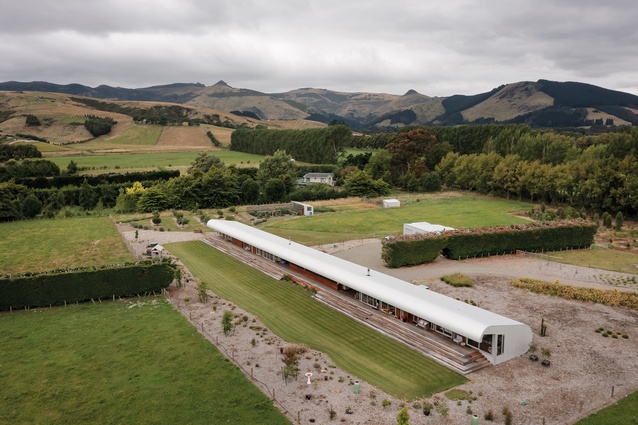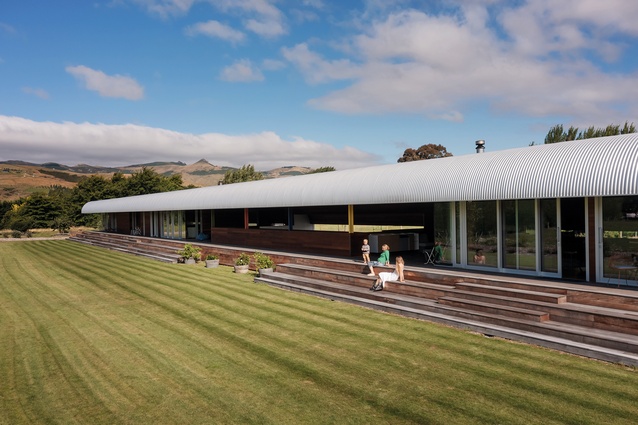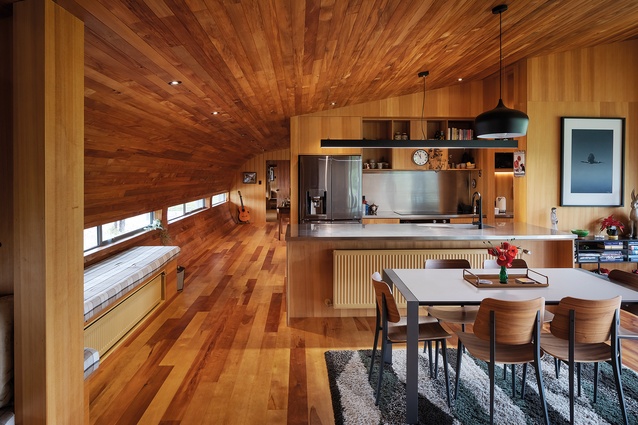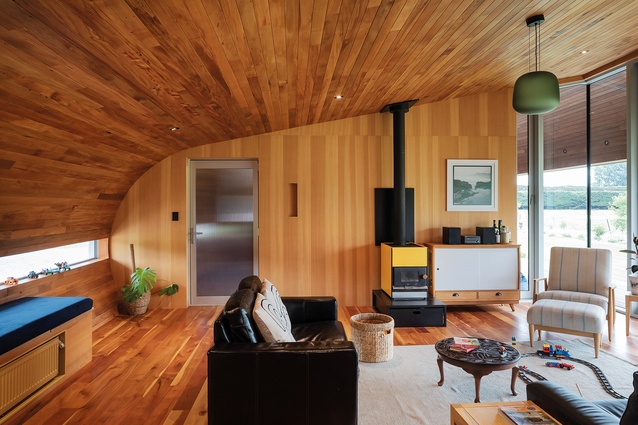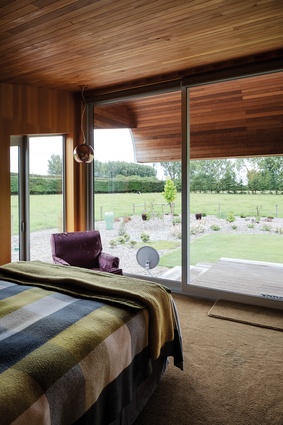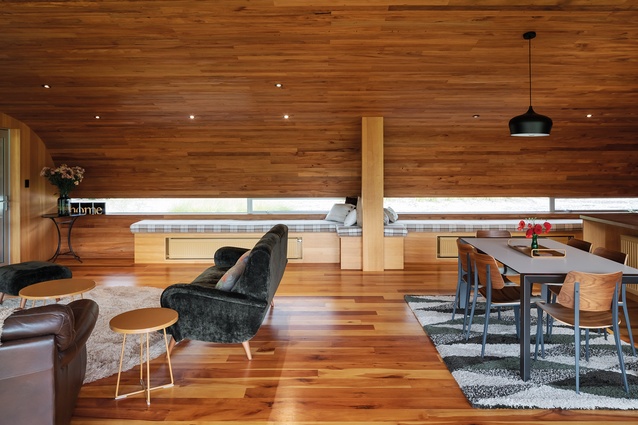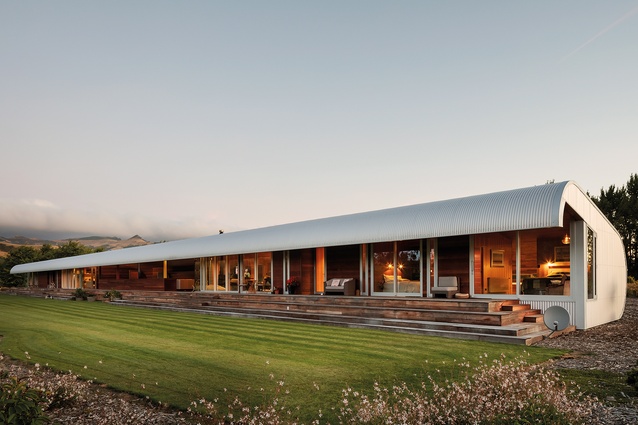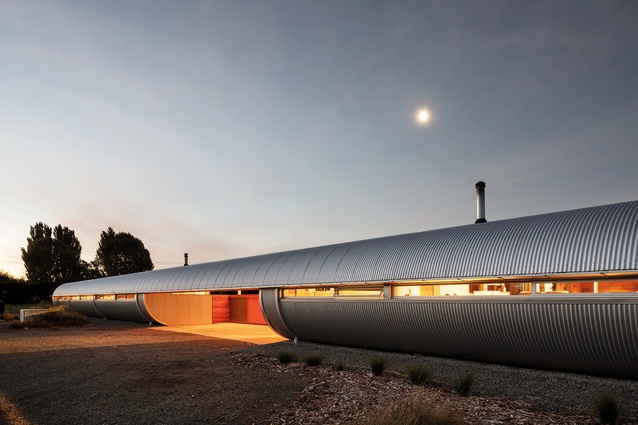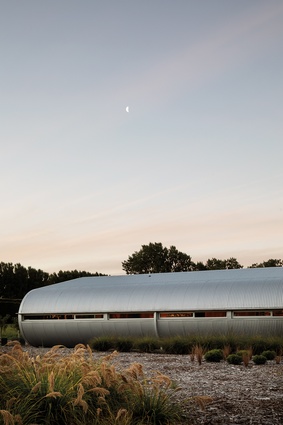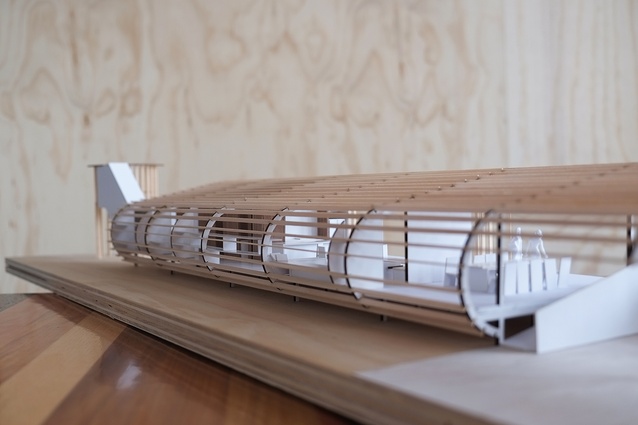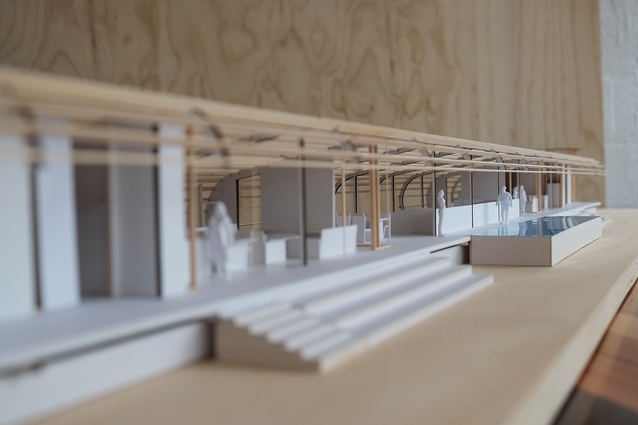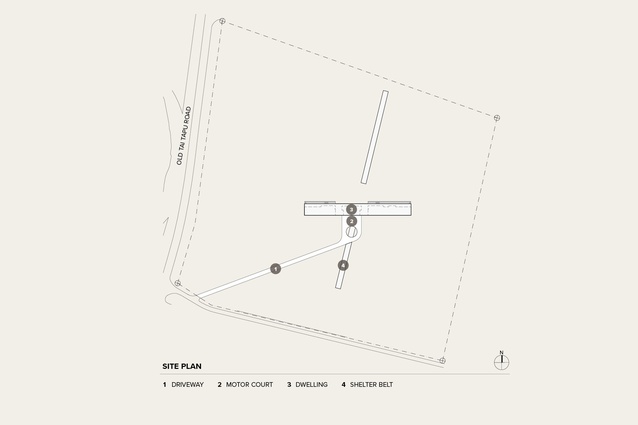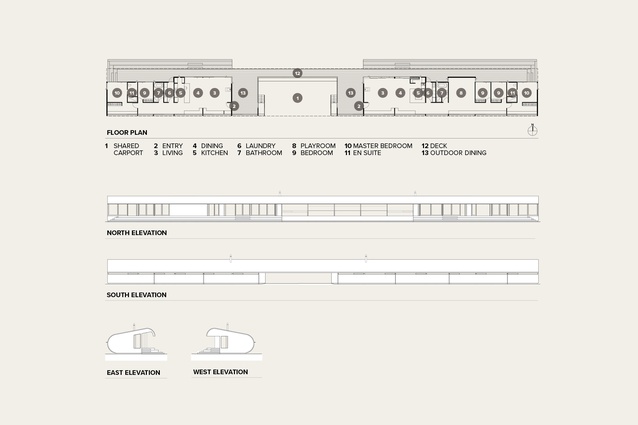Three generations, two houses, one roof
Peter Wood muses on the meaning of Gustorob, Bull O’Sullivan Architecture’s long, elegant shed, landed in a rural Canterbury landscape.
Well, well, Michael O’Sullivan has been up to architectural shenanigans, aginagain. Just when I thought I had his number attached to a frenetic canned design in Cass Bay, he goes back to the straight and narrow with Gustorob, a multi-gen family home landlocked on the Canterbury Plains. Indeed, if you discovered Gustorob and the Cass Bay house separately, you might reasonably assume they are the work of different architects, maybe in different countries (what’s that, Lyttelton and Christchurch are different countries?). But that’s the enigma of O’Sullivan. Just when you think you have him figured out, he peels back the onion and your eyes water all over, aginagain.
Let’s start with that name. I wanted to read it as ‘gusto-rob’ and imagine a particularly energetic thief at work nabbing new ideas. The actual etymology is far more lyrical. Gus is a toddler and Rob is his grandad, who built the house they share: Gus-to-Rob. It’s an O’Sullivan neologism celebrating the importance of family — in all its expressions — as the nucleus of home. In this case, three generations share two houses under one roof, lolling near the Port Hills (or is that LOLing?).
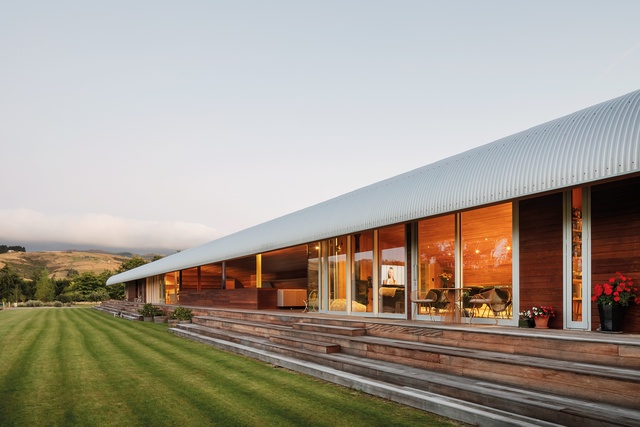
But wait, did I say roof? Wouldn’t that suggest some separation from a wall? And aren’t walls meant to be upright? And floors flat. This looks like a 1950s’ teardrop caravan that was drawn on parametric software by a draughtie who stubbed a cigarette out on the ‘extrude’ button. The floor plan tempers my panic response by displaying a familiar pavilion distribution that has the, ummmm, seniors to the west and the next generations to the east. At this point, another architect might have dedicated the space between the two residential wings as a familial common. But O’Sullivan isn’t that predictable. Under his eye, it becomes an integrated carport. The dwellings remain connected by a walkway, and individual porches extend each home, but he foregoes the expected in order to direct the outlook of both dwellings northward into the Canterbury landscape. This gives the house a particularly uncompromising duality of frontages. The front-front reads like a summer sport clubroom, conceived by a skilled sculptor stamping on a roll of tin foil, while the back-front presents arrivals with a scene from Footrot Flats, had Wal won Lotto and massively overcapitalised the Dog’s water-tank shelter. Or maybe it’s a Roger Walker flashback, a toppled grain silo or a Tīrau tribute, sans eyes and ears. If John Scott really did gift us the woolshed as the archetypal building for New Zealand architecture, could it be that O’Sullivan is doubling down on these agricultural roots and proposing a corrugated irrigation pipe as the next big step? Whatever the case, it would be a mean spirit that did not admit to its being very shed-like, and very elegant. As David Mitchell once espoused on that subject, we Kiwis like the stories about our architects, and their buildings, to be easily grasped. As described by Mitchell, Canterbury architecture struggled under a Christ’s College legacy and, like Sisyphus labouring once more into his boulder, it’s now bonded to pushing tilt-slab modernism to the heights of respectability. O’Sullivan, too, suffers a servitude to other people’s mythological expectations. Heresy is promised to a writer who does not chronicle his wrestling prowess, self-build inclinations, prosperous laugh and prodigious imagination. So much the better if a photographer can find him wearing shorts and holding a paintbrush. It’s all true, but it’s not all that is true of the architect, or the man. It’s too easy to categorise him as a Crumpian-Man Alone and try to find in his work a parallel singularity. Cass Bay confronted this simplification by being too damned sophisticated and, for some, Gustorob might be seen as a comfortable return to the pragmatic neo-modernist humanism O’Sullivan pioneered in his Māngere Bridge home, and continues to experiment with in his Lyttelton Studio. Read through this lens, Gustorob is easily digested as an agricultural building type, continuing a tradition of elegant sheds for a pragmatic people humbled by a dramatic landscape. It does not take much squinting to imagine a colonial figure seated under a bullnose verandah. If that’s what you want to find.

In typically poetic fashion, the Bull O’Sullivan website describes Gustorob as “… a long run sensuous Samoa in semi-rural Christchurch”. While a petulant critic might point to similarities with Australian Peter Stutchbury’s The Hangar, I’m inclined to see it as a vessel in the tradition of DIY dream-yachts that were once scattered across suburban Kiwiland in the 1970s: timber-lined hard-shells built to defend their passengers from an unpredictable world. Trying to conceptualise a project in this way conforms to a search for easily digestible meaning but the important lesson we should take from Gustorob is not that of one story but, rather, we should delight that a building can so easily activate many. This is harder than it might seem. Meaning, like the familiar formation of the pearl, needs a speck of grit to find its initial purchase. That’s okay for an oyster plying a sandy sea floor, but extending this analogy to architecture means finding a cultural context equally awash in uncomfortable irritants. Post WWII, New Zealand was littered with such particulates as a generation of young architects reacted against the prevailing norms of the day. They may have produced only modest pearls but they were from Bluff (well, Auckland).
The difficulty now is that our search for local pearls escalated into a ravenous desire for caviar as the tastes of New Zealanders became more demanding; that includes our architects, who have become experts at producing world-class Chardonnay on craft-beer budgets. We have, in a word, matured, with all the benefits and risks this brings. Mitchell ended The Elegant Shed with the Gibbs House (1984), calling it a pavilion for “lovers of cool and modern architecture” (page 106), and Mark Wigley would soon proselytise it as the arrival of internationalism in New Zealand (well, Auckland again). It feels as though, over the last decade, the cool pavilion has become the standard to which New Zealand architects are being judged. Whether it’s the Herbsts on Great Barrier, Stevens Lawson on Waiheke, Crosson Architects in the North, Irving Smith in the South or Tennent Brown on Stewart, some of New Zealand’s best architects are producing mature island work, increasingly being recognised by our continental cousins for its architectural quality. The houses of Aotearoa are appearing online in international company as examples of the very best of domestic architecture anywhere.
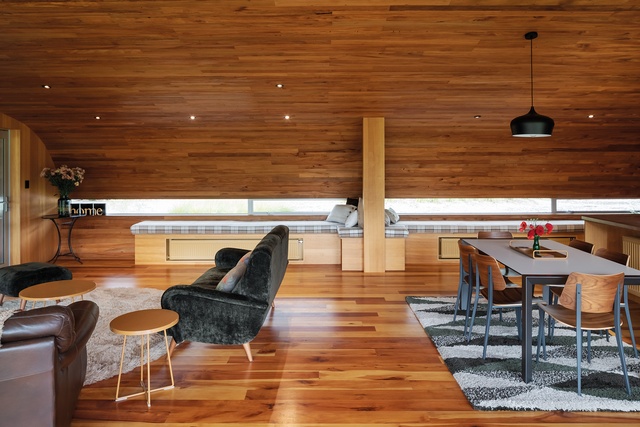
The problem is, in finding the work of New Zealand architects to be as sophisticated as anything anywhere in the world, that work often appears to be indistinguishable from anything anywhere in the world. That’s not a criticism of the architects but it is an observation that the internet, especially the internet, has facilitated a vast proliferation of architectural photographs, many of which become divorced from their geographical and cultural specificity. In this visual economy, to say a New Zealand house is as good as one from Germany, Vietnam, Brazil or Canada is to admit that they all look very alike. That it failed to allow for regional identity was, of course, a principal criticism of modernism. But, in an oddly perverse way, the rigidity of modernism meant that regional derivations were made legible. The current referential practice of New Zealand’s mature architecture is more insidious in that it now lacks the regional foundation promised by Mitchell. Value is found not just in speaking eloquently but in doing so without an obvious accent. By all means speak with the Southern Alps as your backdrop, as long as the colonial twang is kept in check.
O’Sullivan is the exception. His talent, generosity and authenticity are recognised by all as something very special. However, we treat him like the coal mine canary of New Zealand architecture; while O’Sullivan keeps singing great Kiwi songs, the rest of us are fine to hack away at the black gold of international influence.
There is a hopeless logic here. Ignoring overseas trends and examples wilfully invites a parochial blindness. But, constant exposure to these same works invites a blinding overdose of inspiration. Yet, in Gustorob, O’Sullivan manages to find a balance. Myths of elegant sheds and beautiful landscapes play their part but it comes down to family. From Rob to Gus, and Gustorob, living in a grounded submarine? Wonky Nissen hut? Badly scaled drawer pull?

